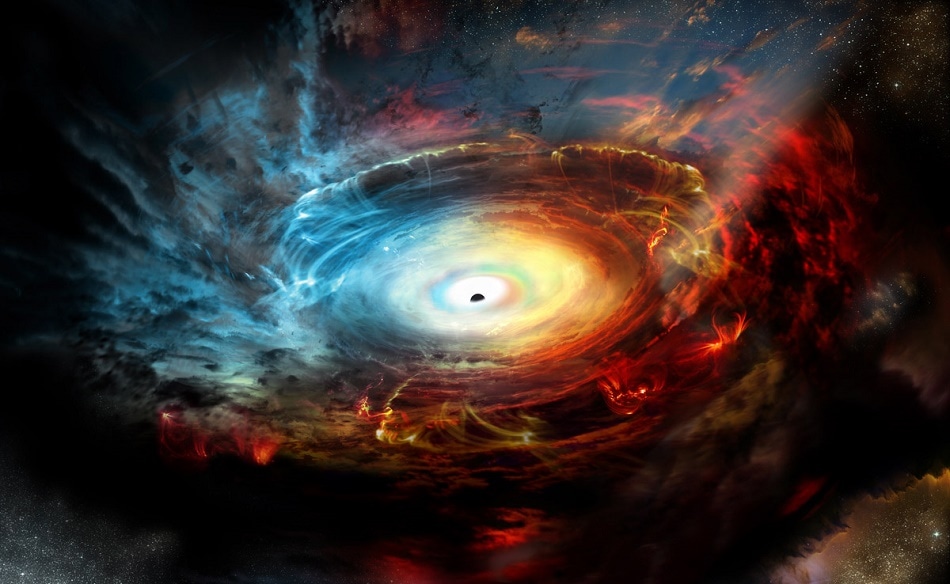Sep 16 2016
 Artist impression of the heart of galaxy NGC 1068, which harbors an actively feeding supermassive black hole. Arising from the black hole's outer accretion disk, ALMA discovered clouds of cold molecular gas and dust. This material is being accelerated by magnetic fields in the disk, reaching speeds of about 400 to 800 kilometers per second. This material gets expelled from the disk and goes on to hide the region around the black hole from optical telescopes on Earth. Essentially, the black hole is cloaking itself behind a veil of its own exhaust. Credit: NRAO/AUI/NSF; D. Berry / Skyworks
Artist impression of the heart of galaxy NGC 1068, which harbors an actively feeding supermassive black hole. Arising from the black hole's outer accretion disk, ALMA discovered clouds of cold molecular gas and dust. This material is being accelerated by magnetic fields in the disk, reaching speeds of about 400 to 800 kilometers per second. This material gets expelled from the disk and goes on to hide the region around the black hole from optical telescopes on Earth. Essentially, the black hole is cloaking itself behind a veil of its own exhaust. Credit: NRAO/AUI/NSF; D. Berry / Skyworks
Supermassive black holes are found at the center of galaxies. These holes are millions to billions of times the mass of the Sun, and they are considered to be galactic behemoths hidden inside a thick doughnut-shape ring of gas and dust called a torus.
Earlier observations highlight that these tire-like, cloaking structures were produced from the native material identified near the center of a galaxy. However, recent data obtained from the Atacama Large Millimeter/submillimeter Array (ALMA) highlights that the black hole found at the center of a galaxy called NGC 1068 is in fact the source of its own dusty torus of gas and dust, forged from material thrown out of the accretion disk of the black hole.
This cosmic fountain of cold gas and dust has the potential to enhance the understanding of how black holes influence their host galaxy and more specifically the intergalactic medium.
Think of a black hole as an engine. It's fueled by material falling in on it from a flattened disk of dust and gas, but like any engine, a black hole can also emit exhaust.
Jack Gallimore, Astronomer, Bucknell University
The exhaust discovered by the astronomers, is expected to become the torus of material that efficiently obscures the area surrounding the supermassive black hole from optical telescopes.
NGC 1068, also called Messier 77, is a banned spiral galaxy almost 47 million light-years from Earth in the direction of the constellation Cetus. NGC 1068 has an active galactic nucleus at its center.
This nucleus is a supermassive black hole that is being filled with a rotating, thin disk of dust and gas called an accretion disk. The material in the disk spirals toward the direction of the central black hole, and it becomes extremely hot and blazes bright with ultraviolet radiation. However, the outer reaches of the disk are found to be significantly cooler and glow more appreciably in infrared light and the millimeter-wavelength light that can be detected by ALMA.
A global team of astronomers used ALMA to look deep into this region and they identified a sprinkling of cool clouds of carbon monoxide lifting off the accretion disk’s upper portion. These clouds are partially ionized by the energy obtained from the hot inner disk, allowing them to adhere to strong magnetic field lines that envelope around the disk.
Just like water being thrown out from a garden sprinkler that rapidly rotates, the clouds mounting above the accretion disk are accelerated centrifugally along the magnetic field lines to extremely high speeds – almost 400 to 800 km/s (nearly 2 million miles per hour).
This is almost three times faster than the rotational speed of the outer accretion disk, as it is fast enough to send the clouds plunging further out into the galaxy.
These clouds are traveling so fast that they reach 'escape velocity' and are jettisoned in a cone-like spray from both sides of the disk. With ALMA, we can for the first time see that it is the gas that is thrown out that hides the black hole, not the gas falling in.
Jack Gallimore, Astronomer, Bucknell University
This highlights that the common theory of an active black hole is oversimplified, he concludes.
The astronomers are planning to come up with a fuel budget for this black hole engine based on the future ALMA observations. This fuel budget will focus on how much mass goes into the black hole every year and how much of the mass is ejected as exhaust.
"These are fundamental quantities for understanding black holes that we really don't have a good handle on at this time," concludes Gallimore.
The National Radio Astronomy Observatory is a facility of the National Science Foundation, functioning under cooperative agreement by Associated Universities, Inc.